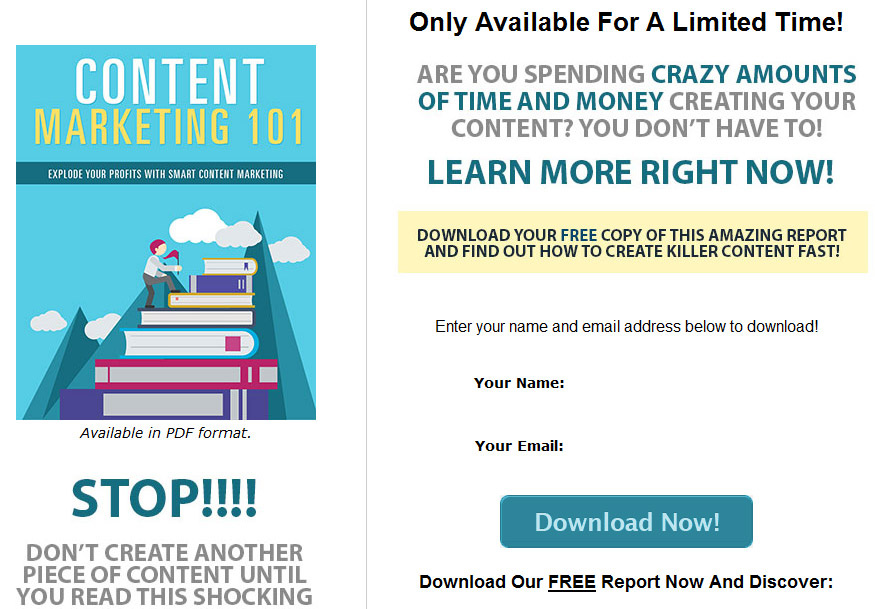Salespage Snapshot:

You will want to include one main call-to-action in every post you make. Whether this is asking people to join your email list or buy a product or whatever else, you need to include this in every article.
Does it have to be the same one in every article?
Absolutely not!
Let’s say you make a post on container gardening. You could definitely link to a squeeze page that offers a beginner’s guide to container gardening as your lead magnet.
Then you make a post on urban gardening. You could create a different lead magnet specifically on the topic of urban gardening.
You obviously won’t want to have a different lead magnet for every single article you write. That would get ridiculous pretty quickly. But the closer your lead magnet is to the exact topic of your article, the more effective it will be.
Here’s another example:
Let’s say the product you have to promote is a build-your-own greenhouse kit. That may be the ultimate product you’d like to promote, but is it the best thing to promote on every single article you create? Probably not.
What if you write an article on how to grow a garden on an apartment balcony?
If you were to promote a build-your-own greenhouse kit in an article on apartment balcony gardening, the odds of making a sale would probably be pretty bad.
The average apartment dweller simply doesn’t have anywhere to put a greenhouse, even if they’d very much like to have one.
As you can see, it’s important to think about the purpose of your content before you create it. If that build-your-own greenhouse kit is your product, and the absolute main purpose of your website, you probably wouldn’t even want to write that article on balcony gardening at all, because this market is NOT your target market.
Once you’ve figure out your main purpose for all the content you create, it’s time to start planning your content. (And planning is an important step!)
Planning Your Content
Planning is a step that a lot of people simply skip, and that’s a mistake. There’s a lot of reasons you want to plan your content in advance instead of just creating content on the fly.
Will you always go 100% by this plan?
Of course not.
If there’s breaking news or some kind of time-sensitive content you need to create, obviously you can break your plan and add that content.
However, planning your content is important for such reasons as:
• So you don’t forget to create event or holiday-centric content
• So you don’t suffer from analysis paralysis deciding what to do
• To make it easier to see what you’ve already done
• To be sure you’re covering all the important topics in your niche
• To make it easier to create content when you’re not 100% into it
There are actually WordPress plugins you can use to make the process easier. Here are three plugins you can use, with pros and cons of each:
http://iblogmagazine.com/wordpress-editorial-calendar-plugins/
You’ll probably want to schedule at least a month in advance, and some bloggers plan a year or more in advance. You can still add in content that is relevant to breaking news and industry trends, but it helps to know what you’ll be doing in the future so you don’t accidentally repeat topics or forget to make a time-sensitive post.
Plus, having an editorial calendar helps when you think of an article topic but you’re not ready to write about it. Just add a note to your editorial calendar, and you can come back to the topic when you’re ready.
This is also especially helpful if you have a multi-author blog, because you can schedule content for each writer without topic overlaps. You definitely wouldn’t want to have three different writers all doing articles on the same topic the same week, unless, of course, they had wildly different angles.
Creating Killer Content
Once you’ve created your content plan, it’s time to start creating the content itself. Remember that you must keep your main goal in mind at all times so that you remember to place those calls-to-action in every single article.
What calls-to-action might you have?
• A lead magnet to get an opt-in subscriber
• A link to purchase a product
• A request to follow you on a particular social media property
• A request to leave a comment on the article
• It could even be a link to another related piece of content on your site or someone else’s
These calls to action should all support the purpose you defined earlier. Whether it’s to grow your traffic, sell a product, get more opt-ins, or whatever else you’ve decided your primary goal happens to be.
Each piece of content you create should also somehow support that particular goal. For example, if your main goal is to promote your knitting patterns membership website, you probably wouldn’t want to create content on jewelry making. (Unless you have a secondary jewelry-making product you can promote.)
Don’t create content simply because you think it will bring traffic to your website unless traffic is your ultimate goal. (And it may be if your goal is to get the highest possible traffic to meet a specific goal, such as bragging rights or because you intend to sell the site later.)
All content should directly support your main goal, so keep that in mind.
If you’re struggling to think of topics, you can browse other similar sites in your niche, as well as social media websites, to see what is currently popular.
Pinterest is a great place to find out what’s currently trending in your niche, because you can take a look at the popular section as well as seeing which articles have been re-pinned the most.
Looking at other sites in your niche will also help you with the next topic we will discuss, which is creating content without having to write something unique every single time.
Easier Content Creation
Content creation can be incredibly expensive and/or time consuming if you create 100% unique content all the time. The trouble is, you really need unique content if you hope to rank well in the search engines.
But there’s good news. You can actually turn other people’s content into unique content without plagiarism, without spinning, without theft, and without a lot of time involved.
The answer is curating content, and there are a number of ways to do this. Let’s take a look at a few ways you can benefit from other people’s content.
1. Roundups – Create lists of related posts from other websites. For example, you could make a post called “The Top 10 Ways to Save Money on Plane Tickets”. Then you’d link to ten different articles on the topic on different websites.
2. Lists – This type of post is easy, because all you have to do is think of several similar things on a particular topic and list them. For example, “10 Essential Lures for Bass Fishing.”
3. Videos – You can embed a YouTube video into a page on your website and give a short description of the video. Your description is unique content, but you don’t have to create any actual content yourself other than the description or summary of the video.
Other Details- 1 Ebook (PDF, DOC), 16 Pages
- 7 Part Autoresponder Email Messages (TXT)
- 1 Squeeze Page (HTML, PSD)
- File Size: 5,915 KB














